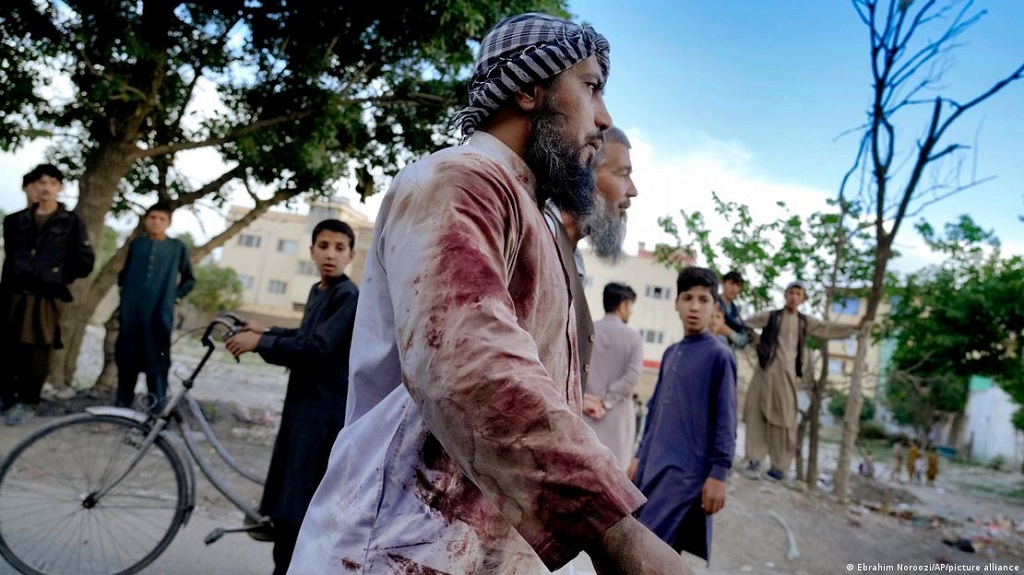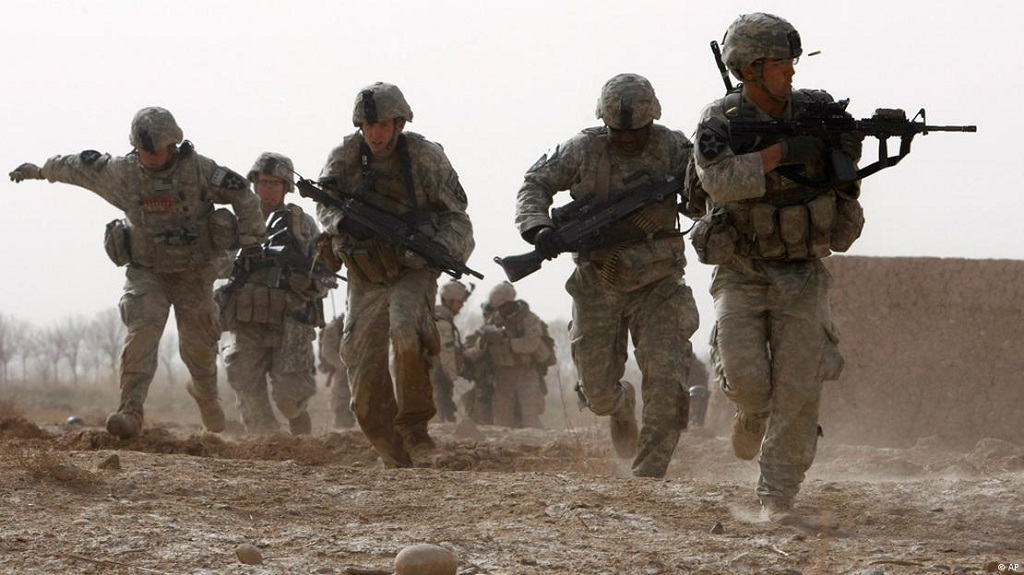The Taliban’s "War on Terror"

It was a rather fusty smelling container that Jawed found himself in after he’d been arrested by two armed Taliban fighters with long beards, turbans and prayer caps. Jawed, 28 (not his real name) had been out walking last autumn and had had to pass through one of the many Taliban checkpoints in the Afghan capital. Normally, the Kalashnikov-wielding fighters would only stop cars and not bother with people on foot.
But the student was unlucky. He had to show his papers and was searched. Then one of the guards grabbed his smartphone. "Open it. Immediately!” he ordered. "No, I won't. You've got no right,” was Jawed’s blunt response. He was then seized, beaten around the head and taken to the nearby container.
This served as both accommodation and a prison cell. While in one corner Taliban fighters sat drinking tea and listening to their 'tarana' battle songs, at the opposite end of the container were young men forcibly detained by the extremists.
Jawed wasn’t the only captive. There were two men sitting next to him. They had long hair and beards and stared grimly ahead. "OK, you've got one more chance. Open your phone," said one of the Taliban soldiers to Jawed, holding out his iPhone. Jawed refused once more. "Then you’ll have to stay here," said the Talib and turned away. A short time later, one of the other detainees whispered to him: "Hey, join us, if you're sick of them too." They introduced themselves as members of the IS cell the "Islamic State – Province of Khorasan".

Taliban perpetuate the cycle of violence
The Taliban have been back at the helm of Afghanistan for almost two years. In August 2021, international NATO forces under U.S.-American leadership pulled out; and after an absence of almost 20 years, the extremists marched into Kabul and seized power. "I have made many sacrifices, but now I’m here as the victor," said senior Taliban figure Ghulam Rohani at the time, during the first media conference by the new, old rulers.
The conference took place at the Arg, the Afghan presidential palace, shortly after the last president of the Afghan Republic, Ashraf Ghani, left the country. The "sacrifices" the Talib spoke of really did happen. He was detained for years at the notorious Guantanamo Bay military torture facility – alongside men who had nothing to do with either the Taliban or al-Qaida and had mostly just been in the wrong place at the wrong time.
The cycle of violence is now being perpetuated by the Taliban. It is first and foremost those Afghans who contributed in some way to their ousting, or who have fought against them in recent years, who are now being made to pay the price. This is why since their return to power, the Taliban have been focused on one thing above all else: the reconstruction of their totalitarian emirate, a dictatorship in which they, and only they, call the shots. Anyone opposing them is hunted down, imprisoned, tortured or killed.
"People are being detained and maltreated in prison for months for posting comments on Facebook," says Mohammad Nabi from the province of Baghlan. He is himself also wanted by the Taliban in other parts of the country. Until August 2021 Nabi, now 27 years old and in hiding, served as an elite soldier in the Afghan army. "I've killed many Taliban in battle. I won’t be forgiven for that," he explains. A neighbour told him about the horrific things that happen in Taliban jails. That neighbour used to work for the NDS (National Directorate of Security), the toppled Kabul government’s intelligence agency.
Long since arrived in the 21st century
"Today he wears a cap, has a beard and long hair and works for the Taliban," says Nabi. The GDI (General Directorate of Security), the now infamous Taliban secret service, replaced the NDS shortly after the extremists' return. It should have been clear, from this point at the very latest, that the image of the uneducated, sandal-wearing, Kalashnikov-toting Talib coming down from the mountains no longer corresponded with today's reality.

Many GDI agents are tech freaks who've taught themselves skills such as hacking or coding and also learnt English, thanks to American TV series or British works of non-fiction on warcraft, political theory and governance. Now these agents, most of them young men, aren't just monitoring social media such as Facebook or TikTok, they're also able to analyse abandoned U.S. databases containing the personal details of Afghan soldiers like Mohammad Nabi.
The Taliban's elite units barely differ in appearance from the U.S. troops they once fought against. One reason for this is the huge volume of U.S. military hardware now in the hands of the Taliban. Much of it was seized during the war. When they pulled out of Afghanistan, the Americans also left vast amounts of equipment gratefully appropriated by the new rulers. The Taliban remain fanatical extremists. But they've long since arrived in the 21st century.
Emirate versus Caliphate
The group that calls itself Islamic State (IS) has also been present in Afghanistan since 2015. Its first members were Taliban renegades. Then came extremists from Pakistan who used to be members of the Taliban movement there, the TTP ("Tehrik-e Taliban Pakistan"). The Afghan Taliban and the TTP pursued different goals despite being intertwined in complex ways.
Whereas the first group mainly opposed NATO and its Afghan allies and was supported in this endeavour by among others the Pakistani establishment, military and intelligence agency, the TTP's sworn enemy was the Pakistani state. Although the TTP had sworn allegiance to the Taliban leader and founder Mullah Omar, internal divisions and discord arose and ultimately led to the terror group's disintegration.
All this changed with the birth of IS. In Iraq and Syria, the new terror organisation dismantled the borders of the modern nation-state, thereby attracting a new generation of jihadists. Men and women who saw their future in a global caliphate, a goal on the IS agenda to this day, and not in a state created by "infidels".
This idea also appeared attractive in Afghanistan. After all, what Francois Georges-Picot and Mark Sykes, the architects of the Sykes-Picot Agreement were to the Middle East, the British diplomat Sir Mortimer Durand was to Afghanistan. The Durand Line that divides Afghanistan and Pakistan to this day was drawn by him in 1893. The border, which runs through Pashtun tribal regions and has regularly caused problems since it was first imposed, is not only rejected by regional nationalists and separatists of a secular nature, but also by a range of Islamist actors.
Those who joined IS in Afghanistan were not just unhappy with the Taliban, they were also much more extremist. Whereas the Taliban largely regard themselves as militant-Islamist nationalists aspiring to an emirate on Afghan territory, IS has a global-jihadist agenda that knows no national boundaries.
And then there are theological differences. Despite their extremist beliefs, the Taliban see themselves as traditionalists from the Hanafi school of Islamic law, to which most of the world’s Muslims adhere today. IS extremists are however Salafists who regard many other Muslims, including first and foremost Shias and Sufis, as "heretics" or "infidels" and therefore persecute them.
"We want to oust them"
"IS is active and present across the entire country. But its resources are limited. The grouping’s chief interest is to discredit Taliban rulers," says British-Afghan analyst Ahmed-Waleed Kakar. In his view, IS ideology would find little uptake with many Afghans. But the Taliban's anti-terror war has resulted in the radicalisation of further sections of Afghan society in recent months.
The Taliban are instrumentalising their anti-IS campaign to ruthlessly crack down on dissidents and any armed resistance. The resulting radicalisation in their opponents' camps hasn't just caught up with the Salafist communities affected by the reprisals, but also the Taliban’s own ranks.
Last March, the Taliban governor of the northern province of Balkh Mohammad Daoud Muzammil was killed in a suicide attack. The attacker had access to Muzammil's office in Mazar-e Sharif. IS claimed responsibility a short time later. The murdered governor had been involved in numerous anti-IS operations.
For many observers, it has been clear ever since: the Afghan IS cell has successfully infiltrated the emirate and is now waging the same battle against the Taliban regime that those now in power previously waged against the Afghan Republic for 20 years. "We want to oust them. They're not Muslims, but nationalist fanatics who are betraying other Muslims," said the IS fighter in the container with Jawed.
He believed he would soon be set free and boasted that his group had supporters across the entire nation, people who they knew how to mobilise. Jawed was allowed to go after one night in the container. "They must’ve realised I was just a student," he remembers today. He doesn’t know what happened to the IS fighters.
It appears likely that Afghanistan will be hit by a new wave of extremism. This is of great concern, not only to the people who live there, but also to regional actors. IS is also said to be attracting extremists from neighbouring nations Tajikistan and Uzbekistan, countries in the grip of authoritarian dictatorships.
Russia regards the IS presence in Afghanistan as a risk factor and has demanded several times that the Taliban implement decisive defensive measures. China, whose citizens have already been targeted in IS attacks in Kabul, is also concerned. A reason given for the attacks, which were described as "acts of vengeance", is China’s oppression of Muslim Uighurs in Xinjiang.
Regional actors are getting involved
"All this will result in at least some of these actors supporting the Taliban in its anti-terror war in some shape or form. But the question is whether the Taliban will accept that support," says Ahmad-Waleed Kakar. This is because any such cooperation would play into the hands of IS propagandists who regularly denounce the Taliban as puppets of foreign forces.
[embed:render:embedded:node:45549]
"From the IS perspective, the Taliban betrayed their pan-Islamist ideals when they signed the deal with the Trump administration that led to the U.S. troop withdrawal," Kakar continues. It's a view long shared by other observers. The well-known Afghan Taliban expert Waheed Mozhdah, murdered in Kabul in 2019 in Kabul said years ago: "At some point the Taliban need to decide whether they want to be nationalists or Islamists. Both just won’t work in the long-term and will get them into trouble, primarily on the global-jihadist stage."
It's a decision that may have already been taken. In August last year, al-Qaida leader Ayman al-Zawahiri was killed in Kabul using new U.S. drone technology. Osama bin Laden’s former number two apparently thought he would be safe in the Afghan capital after the return of the Taliban – and was probably betrayed by his host. Without the help of the Taliban, the targeted murder of the terrorist leader would not have been possible.
It remains to be seen whether the killing of al-Zawahiri actually does represent the Taliban's break with international jihadism. What is clear however is that moderates and hardliners within the Taliban movement have been locked in conflict for some time.
Members of the former group want to cooperate with the U.S. and the world and probably revealed the al-Qaida leader's hiding place, while members of the latter are not only convinced of their ideology, they also fear the movement's disintegration due to divergent opinions. From the Taliban’s point of view, this worst-case scenario would not only spell the loss of power, but also a new open-ended war. For the time being, however, internal strife is being expressed with words, not weapons.
© Qantara.de 2023
Translated from the German by Nina Coon